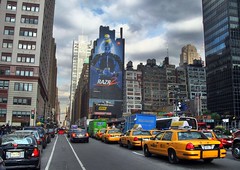The future of news as shown by the 2008 election
From Steven Berlin Johnson’s “Old Growth Media And The Future Of News” (StevenBerlinJohnson.com: 14 March 2009):
The first Presidential election that I followed in an obsessive way was the 1992 election that Clinton won. I was as compulsive a news junkie about that campaign as I was about the Mac in college: every day the Times would have a handful of stories about the campaign stops or debates or latest polls. Every night I would dutifully tune into Crossfire to hear what the punditocracy had to say about the day’s events. I read Newsweek and Time and the New Republic, and scoured the New Yorker for its occasional political pieces. When the debates aired, I’d watch religiously and stay up late soaking in the commentary from the assembled experts.
That was hardly a desert, to be sure. But compare it to the information channels that were available to me following the 2008 election. Everything I relied on in 1992 was still around of course – except for the late, lamented Crossfire – but it was now part of a vast new forest of news, data, opinion, satire – and perhaps most importantly, direct experience. Sites like Talking Points Memo and Politico did extensive direct reporting. Daily Kos provided in-depth surveys and field reports on state races that the Times would never have had the ink to cover. Individual bloggers like Andrew Sullivan responded to each twist in the news cycle; HuffPo culled the most provocative opinion pieces from the rest of the blogosphere. Nate Silver at fivethirtyeight.com did meta-analysis of polling that blew away anything William Schneider dreamed of doing on CNN in 1992. When the economy imploded in September, I followed economist bloggers like Brad DeLong to get their expert take the candidates’ responses to the crisis. (Yochai Benchler talks about this phenomenon of academics engaging with the news cycle in a smart response here.) I watched the debates with a thousand virtual friends live-Twittering alongside me on the couch. All this was filtered and remixed through the extraordinary political satire of John Stewart and Stephen Colbert, which I watched via viral clips on the Web as much as I watched on TV.
What’s more: the ecosystem of political news also included information coming directly from the candidates. Think about the Philadelphia race speech, arguably one of the two or three most important events in the whole campaign. Eight million people watched it on YouTube alone. Now, what would have happened to that speech had it been delivered in 1992? Would any of the networks have aired it in its entirety? Certainly not. It would have been reduced to a minute-long soundbite on the evening news. CNN probably would have aired it live, which might have meant that 500,000 people caught it. Fox News and MSNBC? They didn’t exist yet. A few serious newspaper might have reprinted it in its entirety, which might have added another million to the audience. Online perhaps someone would have uploaded a transcript to Compuserve or The Well, but that’s about the most we could have hoped for.
There is no question in mind my mind that the political news ecosystem of 2008 was far superior to that of 1992: I had more information about the state of the race, the tactics of both campaigns, the issues they were wrestling with, the mind of the electorate in different regions of the country. And I had more immediate access to the candidates themselves: their speeches and unscripted exchanges; their body language and position papers.
The old line on this new diversity was that it was fundamentally parasitic: bloggers were interesting, sure, but if the traditional news organizations went away, the bloggers would have nothing to write about, since most of what they did was link to professionally reported stories. Let me be clear: traditional news organizations were an important part of the 2008 ecosystem, no doubt about it. … But no reasonable observer of the political news ecosystem could describe all the new species as parasites on the traditional media. Imagine how many barrels of ink were purchased to print newspaper commentary on Obama’s San Francisco gaffe about people “clinging to their guns and religion.” But the original reporting on that quote didn’t come from the Times or the Journal; it came from a “citizen reporter” named Mayhill Fowler, part of the Off The Bus project sponsored by Jay Rosen’s Newassignment.net and The Huffington Post.
The future of news as shown by the 2008 election Read More »
